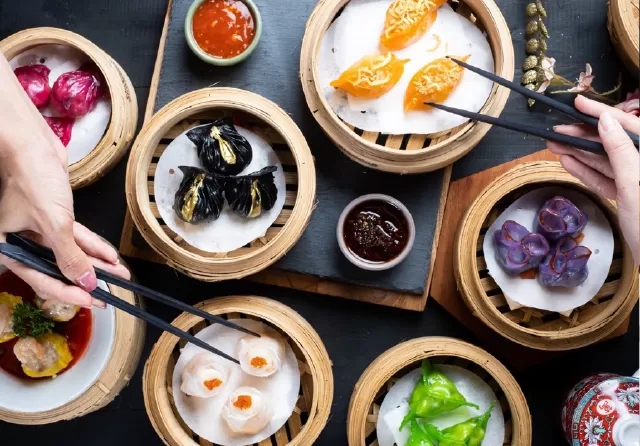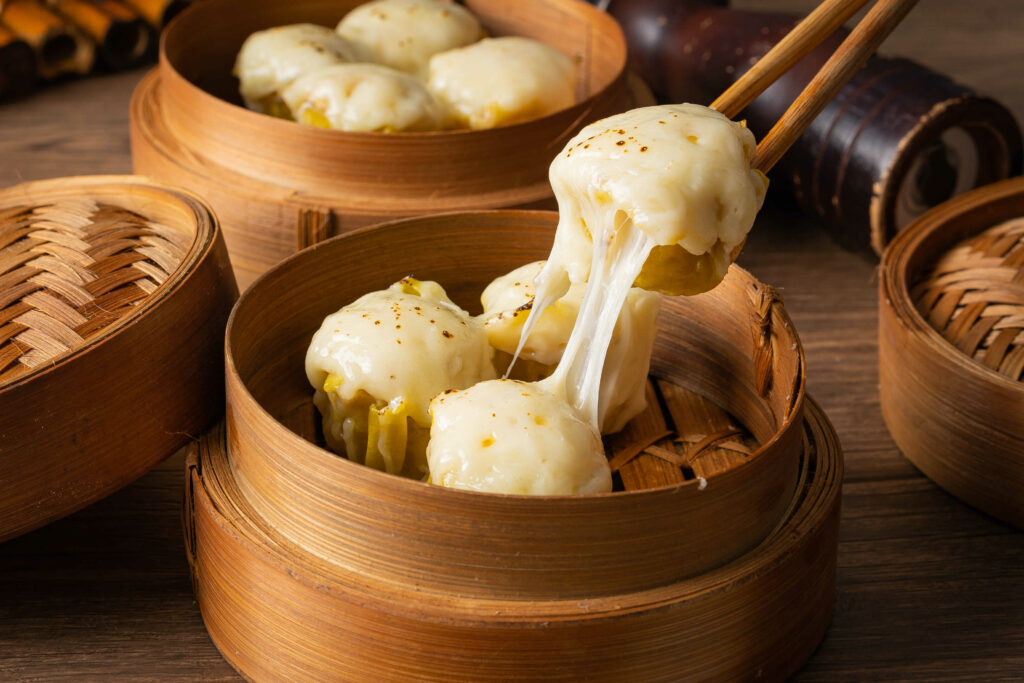
Dim Sum
Dim sum, a traditional Chinese cuisine, has captured the hearts and palates of food enthusiasts worldwide with its delectable variety of bite-sized dishes and vibrant flavors. Originating from the Cantonese region of China, dimsum has evolved into a beloved culinary tradition celebrated for its communal dining experience and diverse array of savory and sweet delicacies. Let’s embark on a journey to discover the rich history, culinary delights, and cultural significance of dim sum.

Exploring the Delights of Dim Sum
A Taste of Tradition:
Dim sum, which translates to “touch the heart” in Cantonese, has its roots in the teahouses and roadside eateries of southern China, where it was originally served as a snack or accompaniment to tea. Over time, dimsum evolved into a social dining experience, with families and friends gathering to enjoy a leisurely meal of small, flavorful dishes steamed, fried, or baked to perfection.
Variety and Versatility:
One of the hallmarks of dim sum is its extensive variety of dishes, ranging from steamed dumplings and buns to fried rolls and pastries, each offering a unique combination of flavors, textures, and ingredients. Popular dim sum dishes include siu mai (steamed pork dumplings), har gow (shrimp dumplings), char siu bao (barbecue pork buns), and egg tarts, among many others. Dimsum chefs showcase their culinary skills through intricate folding, wrapping, and shaping techniques, resulting in visually stunning and irresistibly delicious creations ziatogel.
Cultural Significance:
Dim sum holds deep cultural significance in Chinese cuisine and society, serving as a symbol of hospitality, generosity, and family unity. Traditionally enjoyed during breakfast or brunch hours, dim sum meals offer an opportunity for friends and relatives to gather, socialize, and bond over shared culinary experiences. The communal nature of dimsum dining encourages conversation, laughter, and the sharing of dishes, fostering a sense of connection and belonging among diners.
Tea Pairing Tradition:
Tea plays an integral role in the dimsum dining experience, with a wide selection of Chinese teas chosen to complement the flavors and textures of the dishes. Popular choices include jasmine tea, oolong tea, and pu-erh tea, each offering its own unique aroma and flavor profile. Tea service at dim sum restaurants is often accompanied by the soothing sound of tea being poured from a height to aerate and enhance its taste, adding to the sensory experience of the meal.
Global Influence:
In recent years, dim sum has gained popularity beyond China’s borders, becoming a beloved cuisine in countries around the world. Dim sum restaurants can be found in major cities across Asia, Europe, North America, and beyond, catering to diverse palates and culinary preferences. The global appeal of dimsum reflects its versatility, accessibility, and universal appeal as a flavorful and comforting dining option for people of all backgrounds.
Innovation and Creativity:
While traditional dim sum dishes remain cherished favorites, modern chefs and restaurants are also putting a creative twist on classic recipes, experimenting with new ingredients, flavors, and presentations. From fusion dim sum incorporating international influences to vegan and gluten-free options catering to dietary preferences, dimsum continues to evolve and adapt to changing tastes and trends while staying true to its culinary heritage.
Preserving Tradition:
Despite its evolution and adaptation over time, dimsum remains deeply rooted in tradition, with many recipes passed down through generations of dim sum chefs and families. Dimsum restaurants often uphold age-old cooking techniques and preparation methods, ensuring that each dish retains its authenticity and cultural significance. Through the preservation of traditional recipes and culinary practices, dim sum continues to be cherished as a symbol of Chinese heritage and culinary excellence.
In conclusion, dimsum delights diners with its tantalizing array of bite-sized dishes, rich flavors, and vibrant cultural heritage. Whether enjoyed with family and friends in a bustling teahouse or savored as a comforting meal at home, dimsum offers a delicious and unforgettable dining experience that touches the heart and nourishes the soul.

The Origin of Dim Sum: A Culinary Journey
Dim sum, a beloved culinary tradition in Chinese cuisine, has a rich and fascinating history that dates back centuries. Originating in the teahouses of ancient China, dim sum has evolved into a diverse and cherished dining experience enjoyed by people around the world.
Early Beginnings:
The roots of dimsum can be traced back to the teahouses along the ancient Silk Road during the period of the Tang Dynasty (618-907 AD). Travelers and traders passing through the bustling trade routes would stop at these teahouses to rest and replenish their energy. To accompany their tea, teahouse proprietors began offering small, savory snacks and pastries.
The Tea and Snack Connection:
The term “dim sum” translates to “touch the heart” in Cantonese, reflecting the intention of these bite-sized delicacies to delight the senses and enhance the tea-drinking experience. Over time, dimsum became synonymous with the tradition of yum cha, or “drinking tea,” where friends and family would gather to enjoy tea and a variety of snacks and small dishes.
Evolution and Expansion:
As the popularity of dim sum grew, so did its variety and complexity. Dimsum chefs began experimenting with different ingredients, flavors, and cooking techniques, leading to the development of a diverse array of dumplings, buns, rolls, and pastries. Dim sum evolved from simple snacks to elaborate culinary creations, each with its own unique flavor profile and presentation.
Cultural Influence:
Dim sum reflects the cultural diversity and culinary heritage of China, with regional variations and specialties found throughout the country.
Preserving Tradition:
Despite its global popularity and modern innovations, dim sum remains deeply rooted in tradition, with many recipes and cooking techniques passed down through generations of dimsum chefs and families. Dim sum restaurants often uphold age-old traditions and rituals, ensuring that each dish retains its authenticity and cultural significance.
In conclusion, dim sum is not just a meal; it is a culinary journey that reflects the history, culture, and creativity of China. From its humble beginnings in the teahouses of ancient China to its global popularity today, dim sum continues to delight and inspire food enthusiasts with its diverse flavors, exquisite craftsmanship, and timeless tradition.
Advantages and Disadvantages of Dim Sum
Dim sum, a beloved culinary tradition originating from China, has gained popularity worldwide for its flavorful bite-sized dishes and communal dining experience. While dimsum offers numerous advantages, it also comes with certain drawbacks. Let’s explore the strengths and weaknesses of dimsum dining.
Advantages:
Variety of Flavors:
One of the main advantages of dim sum is the wide variety of flavors available. From savory dumplings filled with meat or seafood to sweet pastries and desserts, dimsum offers something to satisfy every palate.

Social Dining Experience:
Dim sum dining is typically a communal experience, where friends and family gather to share a meal. This fosters a sense of togetherness and allows for lively conversation and interaction while enjoying a diverse selection of dishes.
Bite-Sized Portions:
Dim sum dishes are served in small, bite-sized portions, making it easy to sample a variety of flavors without overindulging. This allows diners to enjoy a diverse culinary experience and discover new flavors and textures.
Customizable Options:
Dim sum menus often feature a mix of steamed, fried, and baked dishes, providing options for diners with different dietary preferences. Whether you prefer meat, seafood, vegetables, or gluten-free options, there is usually something for everyone to enjoy.
Fresh Ingredients:
Quality ingredients are essential in dimsum preparation, with an emphasis on fresh seafood, meats, and vegetables. This ensures that dishes are not only flavorful but also nutritious and wholesome.
Disadvantages:
High Sodium Content:
Some dim sum dishes, particularly those that are fried or seasoned with soy sauce, may have a high sodium content. Consuming too much sodium can contribute to health issues such as high blood pressure and cardiovascular disease.
Caloric Density:
While dim sum dishes are small in size, they can be calorie-dense, especially if they are fried or made with rich ingredients like pork or beef. Overindulging in dimsum can lead to excessive calorie intake, which may contribute to weight gain over time.
Potential for Food Allergens:
Dim sum dishes often contain common allergens such as gluten, shellfish, and soy. Diners with food allergies or sensitivities may need to exercise caution and inquire about ingredients before consuming certain dishes.
Price:
Dim sum dining can be relatively expensive, especially at high-end restaurants or during peak hours. The cost of dimsum can add up quickly, particularly if ordering a large variety of dishes or dining with a group.
Limited Vegetarian Options:
Vegetarians and vegans may find it challenging to find a wide selection of plant-based dimsum options at some restaurants.
In conclusion, dim sum offers a delightful culinary experience with its diverse flavors, bite-sized portions, and communal dining atmosphere. However, diners should be mindful of potential drawbacks such as high sodium content, calorie density, and limited vegetarian options, and make informed choices to ensure a balanced and enjoyable dining experience.
Read More Article About “Hong Kong’s Iconic Skyline: A Glimpse into Urban Majesty“






